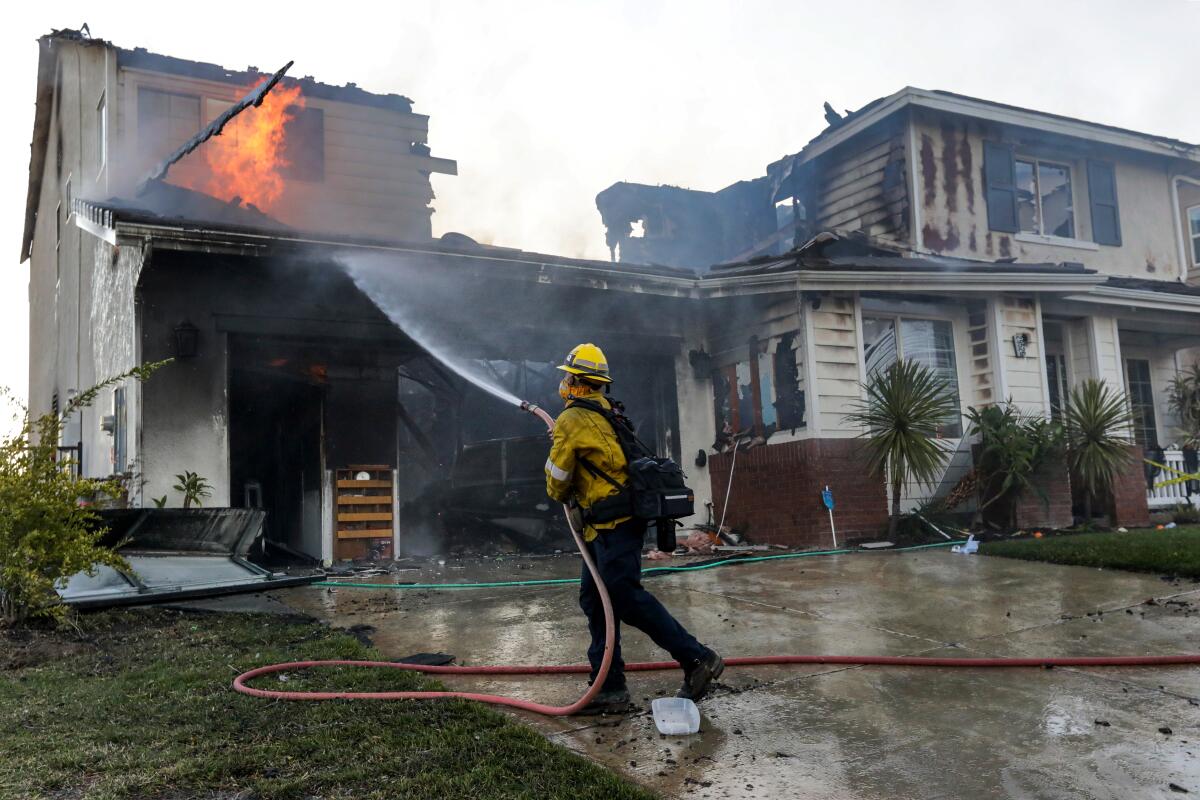Newsletter: It’s fire season. Here are three ways to prepare financially

Good morning. I’m Rachel Schnalzer, the L.A. Times Business section’s audience engagement editor, back with our weekly newsletter. While the financial effects of the coronavirus pandemic are the usual focus of the newsletter, I’m pivoting this week to discuss another crisis facing Californians: the wildfires that plague vast areas of the state. Last week, more than 136,000 people in Northern California were evacuated as a result of the fires. In addition to the loss of human life, experts believe the fires could claim more than 3,000 homes and structures.
With roughly four more months of fire season ahead, it’s a good time to think about how you can prepare financially in case a fire damages or destroys your home. Here are three steps you can take:
Make sure you have adequate insurance coverage
Your home insurance may not be enough to cover damage caused in a fire. “Two-thirds of the fire victims that we’ve worked with over the years have found themselves under-insured in one category or more,” says Amy Bach, executive director of the consumer advocacy group United Policyholders. Insurance coverage is divided into “buckets,” Bach explains: a bucket for your dwelling, a bucket for your personal property, a bucket for temporary rent, and so on. Usually, people do not have enough coverage in their dwelling bucket, she says.
Bach provides an example: “Let’s say you have a 2,000-square-foot house, and it burns to the ground. A builder says it’ll cost $1 million for you to put it back. … [You may only] have $800,000 worth of insurance, even though you should have had a million.”
There’s an easy way to gauge whether you’re relatively well-insured in the event of a fire, Bach says. Just divide the amount of insurance you have in your dwelling bucket by the square footage of your house. You should have at least $200 of dwelling coverage per square foot of your home, she says.
Bach recommends working with a “pro-consumer” insurance agent who will help you customize your insurance coverage to account for the features of your property, such as a pool or outbuildings.
She also advises homeowners to keep in touch with their insurer and ask whether they feel you have enough insurance. Take notes from this conversation and put them in a safe place in case you need to show your insurance company later that you’d been assured you had enough coverage. Those notes can make a difference, she says.
Another tip? Read every piece of mail your insurer sends you and keep an eye out for new exclusions that the company may try to add to your policies, Bach recommends.
Times columnist David Lazarus, who has reported on fire preparedness in recent years, suggests that homeowners consider paying extra for an extended replacement cost endorsement, which “will cover at least a portion of unexpected cost increases in the event you have to rebuild.” He also recommends thinking about purchasing code upgrade coverage, in case rules have changed in the time since the house was built.
And even if you’re a renter, you should still think about getting insurance. Your landlord’s insurance does not protect your possessions, Bach explains, in the event that they’re damaged or destroyed in a fire. The good news? Renter’s insurance is fairly inexpensive.
If you’ve already been affected by the fires and feel concerned about your insurance coverage, United Policyholders may be able to help. “Our main work that we do is helping people get every dime of insurance after they’ve had a loss,” Bach says. Visit their website to learn more and find resources.
Document your possessions
Before disaster strikes, it’s a good idea to document all of your possessions to avoid issues down the line with your insurance company. This applies to homeowners and renters, Lazarus says. Just take a video walking around your home, so your insurers have proof of your possessions. “This can be very helpful if an insurer balks at, say, replacing a top-of-the-line computer or home-theater setup,” Lazarus says.
While you’re filming around your house, Cal Fire recommends describing the contents of your home, how much items cost and when you purchased the items. The department also suggests that you save receipts for big-ticket purchases and store them in the cloud or away from your home.
Prepare a bag with important financial information
Listos California recommends preparing a go-bag with items you will need in case you need to evacuate your home. Justin Knighten, a co-chair of the Listos California Emergency Preparedness Campaign, says you should include copies of your identification, ATM cards, insurance information and immigration paperwork, in addition to a small amount of cash in case you have difficulty finding an ATM during a disaster. This way, “you have at least important documentation that you’re going to need later,” Knighten says.
Another item to stash inside your go-bag? “Make sure you have enough face masks,” Knighten advises. And if you have to evacuate to a shelter, “still be aware of the fact that physical distance practices are critical for you and your family.”
Additional resources and tips for financial preparedness in the event of a fire:
◆ California Department of Insurance
◆ LISTOS California preparedness check list
◆ Ready.gov financial preparedness tips
◆ Cal Fire financial preparedness tips
◆ United Policyholders professional help directory
◆ California Fair Plan (This is an option for those who are unable to obtain insurance in the voluntary insurance market.)
Consider subscribing to the Los Angeles Times
Your support helps us deliver the news that matters most. Become a subscriber.
Other stories you may find helpful
◆ The Federal Reserve is likely to keep interest rates at rock bottom for even longer than previously expected, writes Don Lee. He explains who stands to benefit.
◆ Homeowners struggling amid the pandemic can expect some relief. Fannie Mae and Freddie Mac will continue to suspend mortgage foreclosures through at least December 2020, Bloomberg reports.
◆ President Trump and drug companies have secret plans to lower prices, writes columnist David Lazarus. But experts say their plans will not get the job done.
◆ Los Angeles’ Broadway Federal Bank and Washington, D.C.’s City First Bank are merging to form the largest Black-led bank in the U.S. Samantha Masunaga and Suhauna Hussain explain how this merger speaks to the challenges Black-led banks may have in generating capital.
◆ Instacart shoppers say they face unrealistic expectations, Johana Bhiuyan reports. She spoke with several shoppers who describe how part-time work for Instacart is “a very easy job to lose.”
◆ Workers and customers are catching COVID-19. Margot Roosevelt describes how businesses are launching fierce campaigns for measures to protect themselves from lawsuits related to the virus.
◆ The Big Business attack on the California Consumer Privacy Act is moving to the ballot box, writes columnist Michael Hiltzik. He outlines what you should know about Proposition 24 and the battle against it.
Reader question
A reader asked us: Is it safe to bring our maid back for cleaning? She is coming to our house by bus, from Van Nuys to Westwood.
Only you and your cleaner can decide how much risk you’re comfortable with. But if you choose to employ a person to clean your home, there are things you can do to lower the chances of spreading the virus.
According to guidance from the California Department of Public Health, you should be taking steps such as providing personal hand sanitizer for your cleaner and refilling it as needed. In addition, you should provide face coverings for your cleaner or reimburse them for the purchase, and wear face coverings yourself when interacting with them. The Health Department “broadly requires the use of face coverings for both members of the public and workers in all public and workplace settings where there is a high risk of exposure,” though exemptions are allowed. If anyone in your residence tests positive for COVID-19, experiences COVID-19 symptoms or goes under quarantine, you must postpone all in-home cleaning services.
Dr. David Eisenman, professor-in-residence at the UCLA Fielding School of Public Health, also recommends maintaining physical distance from your cleaner, for your safety and theirs. “Avoid being in the same room at the same time,” he says. Eisenman suggests having your cleaner work on only part of the house per visit — that way, you and your family can stay in another part of the house, limiting your exposure. Another way to limit your exposure? Arrange to leave the house or spend time in the yard while your cleaner is working.
In addition, it helps to open up all windows, and even the doors, Eisenman says. “The more ventilation you can get in, the better.”
I strongly recommend reading through the CDPH’s guidance and developing a COVID-19 prevention plan before your cleaner returns to your home. The L.A. County Department of Public Health also has a Guidance for Custodial Staff sheet, which pertains to cleaning services in public places. It may be a useful resource as you take precautions.
One more thing
Did you know that delaying your Social Security retirement benefits beyond age 62 results in significant growth each year? Certified financial planner Liz Weston explains why it makes sense to play the Social Security waiting game.
Have a question about work, business or finances during the COVID-19 pandemic, or tips for coping that you’d like to share? Send us an email at [email protected], and we may include it in a future newsletter.
Inside the business of entertainment
The Wide Shot brings you news, analysis and insights on everything from streaming wars to production — and what it all means for the future.
You may occasionally receive promotional content from the Los Angeles Times.




